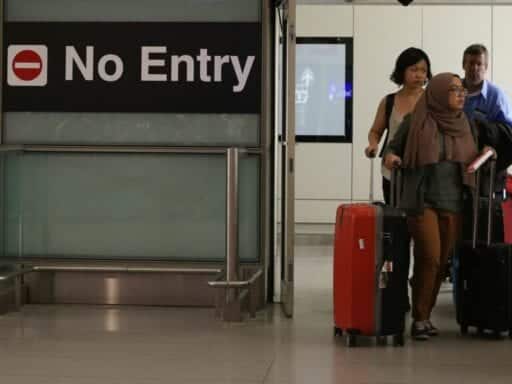State Department guidance sets a higher bar for some people — and it’s especially high for those hoping to immigrate to the US to live with family.
Nine months after the Trump administration’s travel ban fully and permanently went into effect, the public is finally beginning to get some insight into how it’s being implemented — and whether the administration is actually as willing as it has claimed to give waivers to worthy visa applicants.
Documents from January 2018, newly obtained by the International Refugee Assistance Project (IRAP) via a Freedom of Information Act request and shared with Vox, show the official guidance on the ban provided by the State Department to consular officers (who are responsible for conducting visa interviews and approving or denying visa applications).
The documents show that in practice, the standards to qualify for a waiver are more restrictive than the administration has implied — and that for people seeking to come to the US to live with close relatives, they may be nearly unreachable.
From the outside, the implementation of the ban has been puzzling — particularly to people who thought they’d qualify for waivers given what the administration has said in public, but have yet to get their waivers approved or have had them denied. (More than two dozen of those people filed a lawsuit against the federal government in July demanding more transparency about the process.)
The internal (and substantially redacted) documents don’t necessarily contradict the extremely limited information that’s been provided to the public or to members of Congress about how people from one of the seven countries covered by the ban — Iran, Libya, North Korea, Somalia, Syria, Venezuela, and Yemen — can actually be approved to come to the US. But they go into more detail about the standards that visa applicants are supposed to meet to receive a waiver — particularly the requirement that an applicant show they’d suffer “undue hardship” if they were denied a visa under the ban.
Two former consular officials have said that it’s all a sham, and that the Trump administration has set the standards so high that waivers are practically unobtainable. The new documents don’t quite prove them right. They do show that for one particular class of people who are supposed to be considered for waivers — applicants seeking to immigrate to live with close family members — the standards are a lot more restrictive than advertised.
The travel ban has become permanent partly because the Trump administration promised to provide waivers
The current version of the travel ban was introduced by the Trump administration in September 2017; it’s been fully in effect since a court ruling in December 2017. In June, the Supreme Court upheld the current ban — partly on the grounds that the administration had designed it to meet a national security need, rather than for the sake of barring people based on their nationality. One of the features of the policy the court majority pointed to, to make this argument, was the possibility of waivers for some people covered by the ban.
The ban covers certain groups of visa applicants from Iran, Libya, North Korea, Somalia, Syria, and Yemen — with effects that range from fairly narrow (the restrictions on Venezuela only ban officials of particular government ministries from getting temporary visitor visas) to extremely broad (the ban covers all visas for all North Korean nationals, and only makes exceptions for three types of temporary work/study visas from Iran).
But while the standards for temporary visas vary greatly, visas that allow someone to permanently settle in the US (generally called “immigrant” visas, as well as visas granted through the diversity visa lottery) are banned across the board for nationals of Iran, Libya, North Korea, Somalia, Syria, and Yemen.
In theory, the government is supposed to review the ban every six months to determine if it’s still necessary. (Chad, which was added to the list in September due to what appears to have been a shortage of passport paper, was removed in April.) But Iran, Libya, Somalia, Syria, and Yemen have been covered by every iteration of the travel ban stretching back to January 2017; for them, the ban appears to be indefinite.
One of the things that distinguished the third, indefinite version of the ban from its predecessors — and allowed it to be upheld by the Supreme Court in full — is that the Trump administration laid out not only groups of people who were simply exempt from the ban (like people who already held valid visas to enter the US) but also standards by which a theoretically banned person could apply for a visa anyway and get considered for a waiver.
Here’s how that process works: An applicant is supposed to just apply for a visa, the same way they would if the ban weren’t in effect.
The consular officer, in addition to figuring out if the person is in fact covered by the ban, is supposed to check whether they meet three standards: 1) they’d suffer “undue hardship” if the visa were denied; 2) it’s in the “national interest” of the United States to let them in; 3) they don’t pose a public safety or security risk. Meet these standards and the consular officer is supposed to grant them a waiver.
The presidential proclamation in September 2017 that implemented the ban listed several cases in which someone might meet these standards: If an applicant wanted to live with a “close family member” in the United States, for example, or had “significant business or professional obligations” here.
The proclamation didn’t specify what this meant — whether people who fit one of those categories would generally be granted waivers, or whether people would have to fit one of those categories to be considered for one. It instructed the departments of State and Homeland Security to fill in the details with guidance to their field agents.
Administration officials — and the Supreme Court’s conservative justices — pointed to the waiver process as evidence that the Trump administration wasn’t seeking to bar all nationals of a certain country, just take prudent security measures.
While Solicitor General Noel Francisco told the Supreme Court in oral arguments that he thought the travel ban was constitutional with or without a waiver, he did cite it as a similarity between this ban and previous executive orders limiting entry. In Chief Justice John Roberts’s majority opinion in the case, the waiver was cited as one of three features of the policy supporting the government’s claim that the ban was motivated by “national security interest.”
But by that time, questions were mounting about how the waivers actually worked. By April 30, shortly after the Supreme Court heard oral arguments on the ban, only 578 waivers had been approved — an approval rate of 2.5 percent — and several people who seemed to fit some waiver criteria had been denied. In June, Slate obtained testimony from former consular officers saying they were instructed to find any reason possible to deny the visa, and only pass them on for waiver consideration if those efforts failed.
While the pace of waivers has picked up in recent months — 1,607 have been granted between December 8 and August 31, with 611 in July and August alone — we don’t know how many people are being denied waivers or are still stuck in processing. And until now, we didn’t even know what field agents were being told to look for.
Internal guidance shows the standards for “undue hardship” are higher for some people than others
The guidance obtained by IRAP is dated January 25, 2018. Consular officers confirm it’s consistent with their current guidance (except for the inclusion of Chad, which is now off the ban list). It offers more details about how officers can judge whether someone meets the three standards for a waiver, especially “undue hardship”: making it clear that there has to be a reason for the applicant to travel now instead of later, and that suffering in the country you’re in now doesn’t count as “hardship” justifying coming to the US.
It doesn’t explicitly contradict anything that administration officials have said about how the ban operates. But it does make clear that one group of people who lawyers had thought were included on the list of potentially worthy cases — parents of adult US citizens and green card holders who sought to live with their children — in fact are not.
According to the text of the proclamation, a visa applicant might be worthy of a waiver if they seek to live with “a close family member (e.g., a spouse, child, or parent).” Based on that definition, many parents of adult US citizens and green card holders have tried to come to the US to live with their children — often to help care for US-born grandkids. But according to the internal guidance, people only fit in this category if they want to live with a spouse, parent, or unmarried child under the age of 21.
Because a US citizen can’t actually apply for her parent to immigrate until she turns 21, this raises questions about who, exactly, would be able to apply for a visa on these grounds.
People who don’t explicitly fall into one of the categories listed in the proclamation — such as, apparently, parents of adult US citizens — might still be eligible for waivers, but they have to be specifically preapproved by the central visa office.
Crucially, though, the guidance shows that people who do fit into one of these categories aren’t exactly likely to get approved for waivers. Essentially, that’s just the first step — they then have to prove they meet the three standards of “undue hardship,” “national interest,” and security. And depending on which category they fit into, the standards might be fairly easy to meet — or they might be impossible.
Specifically, the guidance goes into detail about how consular officers are supposed to define “undue hardship.” It tells officers that someone only faces “undue hardship” if they need to travel to the US immediately — if it would “defeat the purpose of travel” to wait for the US government to lift its ban on the country in question.
Someone who’s traveling for, say, a week-long business conference is much more likely to meet that standard than someone traveling for a job; someone traveling for a job is more likely to meet it than someone immigrating to meet with family.
The problem, of course, is that the US may not ever lift visa restrictions for some of these countries — or, at least, won’t until President Donald Trump leaves office (and possibly later). So people are likely being denied waivers because they can hypothetically come to the US “later,” even though that “later” will never actually come.
Additionally, officers are instructed not to consider conditions in the applicant’s country of origin, or where the applicant is living now, when judging “undue hardship.” In other words, applicants like the Alghazali family I spoke to this summer — who were struggling to survive in Eritrea after fleeing war-torn Yemen, with a husband and child who are US citizens and a wife covered by the travel ban — aren’t necessarily facing “undue hardship” just because they may not be able to survive for months or years before being allowed to come to the US.
At the same time, the “undue hardship” standard is lower for applicants who get high points for “national interest.” Permanent residents of Canada, for example, don’t have to show as much hardship, because the Trump administration has decided it’s in its interest not to screw up diplomatic relations with Canada too badly. This, too, cuts against close family members of US citizens and green card holders. After all, the Trump administration doesn’t believe that family-based immigration is in the national interest, period.
All of this stacks the deck against people who are trying to move to the US for good; whose reasons for moving are grounded in relationships rather than discrete professional obligations; and for whom moving is urgent because they’re facing danger or instability in their home countries. In other words, it works against people from banned countries who want to come live with family in the United States.
Waivers might be stuck in the same security bottleneck — or quicksand — as refugee admissions
The biggest question about the waiver process has been how the government determines that an individual isn’t a security threat if it’s already declared that everyone from that country should be assumed to be one. The newly released guidance doesn’t provide much insight into that; most references to the security examination process are redacted.
But between the redactions, it’s clear that the decision to grant a waiver doesn’t exactly belong to consular officers. They are responsible for determining whether someone faces undue hardship and would further the national interest, and are then supposed to send on the application for further security assessments — which the document warns are “resource intensive for posts and interagency partners.”
It’s not clear who exactly those “interagency partners” are. But descriptions of the waiver process from consular officers indicate that the State Department requires a separate security check called a “Security Advisory Opinion” in all travel-ban cases before a waiver is granted. SAOs, as they’re called, are traditionally issued in special cases where a visa application raises some concerns or red flags. Since January 2018, they’ve become standard for all would-be refugees as well.
Of course, refugee admissions have been massively bottlenecked over the last year — the Trump administration is set to end fiscal year 2018 barely halfway to the refugee “ceiling” it set for the year — largely because of slowdowns in the SAO process, particularly with the FBI’s portion of the checks.
It’s not clear if the FBI slowdown is a simple capacity issue or if, as some officials say, it’s a way for the Trump administration to avoid having to let people come to the US. But it seems that the biggest problem for refugees also applies to travel ban waiver seekers.
At the same time, though, the fact that someone has to be put through a security check that can take months (or longer) raises questions about the “undue hardship” standard given to consular officers. If an applicant only qualifies for “undue hardship” if she needs to travel immediately but she will have to wait six months or longer to have her name cleared by the FBI, who will ultimately end up getting a waiver at all?
Author: Dara Lind



